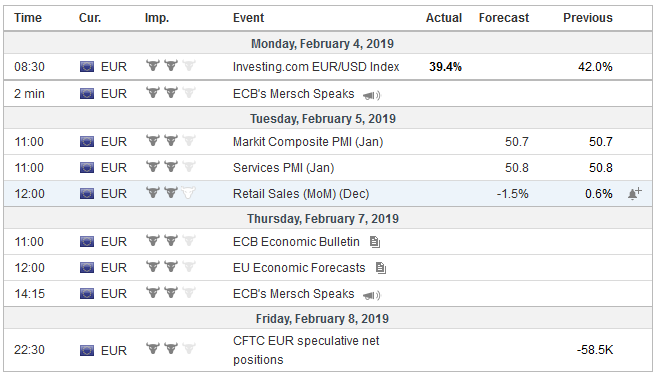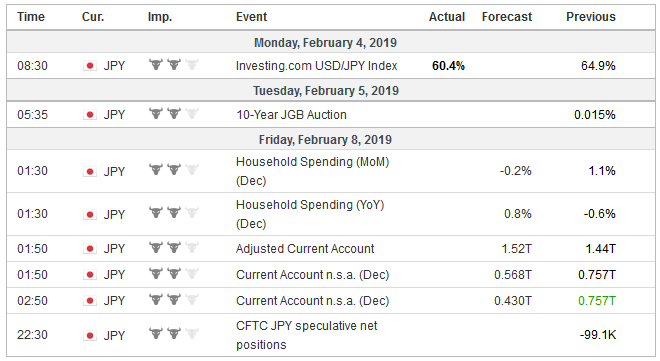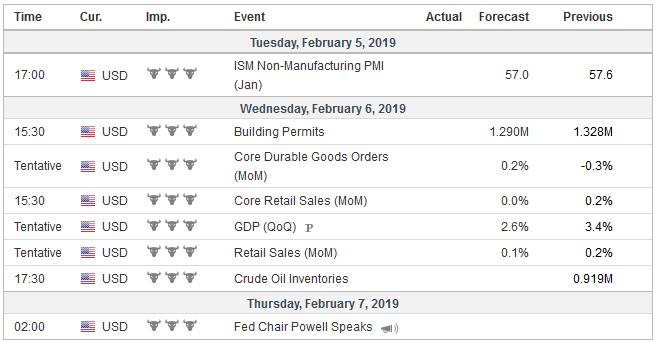The information set investors have is unlikely to substantively change in the coming days. The important macro points are known. The first part of February may be about digesting and making sense of that information rather than an incremental increase. Investors had been concerned about what has become known as “quantitative tightening” or “QT”. It is the opposite of QE. Collectively the central banks’ balance sheets were no longer to be growing on a net basis. This does not seem to be the case anymore. The first thing that needs to be thought through is the shift back toward accommodation. The People’s Bank of China has announced several steps already, including a swap facility for perpetual bank capital bonds,
Topics:
Marc Chandler considers the following as important: 4) FX Trends, AUD, EUR, Featured, GBP, newsletter, SPX, treasuries, USD
This could be interesting, too:
Nachrichten Ticker - www.finanzen.ch writes Die Performance der Kryptowährungen in KW 9: Das hat sich bei Bitcoin, Ether & Co. getan
Nachrichten Ticker - www.finanzen.ch writes Wer verbirgt sich hinter der Ethereum-Technologie?
Martin Hartmann writes Eine Analyse nach den Lehren von Milton Friedman
Marc Chandler writes March 2025 Monthly
The information set investors have is unlikely to substantively change in the coming days. The important macro points are known. The first part of February may be about digesting and making sense of that information rather than an incremental increase.
Investors had been concerned about what has become known as “quantitative tightening” or “QT”. It is the opposite of QE. Collectively the central banks’ balance sheets were no longer to be growing on a net basis. This does not seem to be the case anymore.
The first thing that needs to be thought through is the shift back toward accommodation. The People’s Bank of China has announced several steps already, including a swap facility for perpetual bank capital bonds, which seems like a re-capitalization initiative and the suspension of automatic margin calls. To attract foreign investment, Chinese regulators will allow Qualified Foreign Institutional Investors (QFII) to trade futures and options, for which they have been pressing.
EurozoneThe European Central Bank took the unusual step of lowering its risk assessment before taking onboard updated staff projections. The dovishness might traditionally have been opposed by the Bundesbank, but Germany is at the center of a slowdown in the eurozone. It January manufacturing PMI was revised lower–from the 49.9 flash reading to 49.7-from 51.5 in December. Retails sales, perhaps skewed by account fo gif cards, collapsed by 4.3% in December. BBK President Weidmann warned that German growth may undershoot 1.5% (estimate of potential). A consensus appears to be growing in favor of new long-term loan facility, which would allow banks to roll-over current borrowings before they fall into short-term funding regulations. Also, it may spark some net new interest. The net effect is that previously, the paying back of the borrowings was projected to shrink the ECB’s balance sheet. This no longer looks likely, and to the contrary, it might even expand a little. Ideas that the ECB could raise interest rates as early as “after the summer” has been pushed out, with a 10 bp increase not fully discounted until early 2020. |
Economic Events: Eurozone, Week February 04 |
JapanThe Bank of Japan recently shaved its GDP and inflation forecasts. Its balance sheet continues to expand, though at a slower pace than a year ago. Its benchmark 10-year yield again offers a negative yield. In fact, estimates suggest there is around $7-$8 trillion worth of bonds with negative yields. Federal Reserve Chair Powell increased the public information set about the balance sheet. He indicated that the balance sheet may closer to its optimal size than recognized and that, although it is not an active policy tool now, it could become so again. It also seems possible that the Fed could taper the unwinding as it did with the asset purchases. It also gradually increased the pace of the roll-off before reaching the current target of $50 bln a month (though operationally, it is falling short of its target). The large countries are still too weak to normalize monetary policy. The immediate reaction was to buy risk assets. Global equities rallied. The MSCI Emerging Markets Index rallied 8.7%. The strongest of the major currencies were the dollar bloc, often seen as levered to global growth, and an expression of risk appetites. The high volatile South African rand was the strongest currency, appreciating 8% in January. However, the V-recovery after the December plunge has now approached key areas. The MSCI EM Index peaked in early February 2018, and the bounce has brought it near the minimal retracement levels that one might expect. Other major benchmarks are near key levels. Our target for the S&P 500 has been 2700. It was a conservative target, just below an important retracement target and the 100-day moving average, which the benchmark has not traded over since mid-October. The S&P 500 surpassed our target with the help of the Fed’s dovish pivot. Europe’s Dow Jones Stoxx 600 is also testing its 100-day moving average and a retracement objective. The Nikkei is knocking up against 31000, which support in Q4 18 |
Economic Events Japan week February 04 |
United StatesThe US cut taxes and boosted spending and lo and behold the deficit got larger. The market has to digest the supply that it entails. Moreover, the Federal Reserve’s bid is smaller than was the case previously (before Q4 18). Foreign central bank intervention also may have eased suggesting that the private sector has to buy more. The flatness of the US curve makes it expensive the currency risk for foreign investors. The US will sell $84 bln of coupons as well as a bevy of bills. Many suggest that curve is an important signal from investors. However, sometimes it seems that the role of supply is under-appreciated. The debt managers at Treasury concentrate the issuance at the short-end coupons. Case in point: next week, the three-year note sale will raise $38 bln, while the 30-year bond raises half as much. The one-two punch of robust jobs growth and an upbeat surprise from the ISM, helped by a large rise in new orders boosted yields off their lows, but prices seem rich unless the economy or inflation weaken significantly. The US primary dealer system does not produce uncovered auctions, the issue is always about the distribution and price. The risk is that dealers get stuck with too much inventory and have to mark it down to sell. |
Economic Events United States week February 04 |
Switzerland |
Economic Events Switzerland week February 04 |
No impetus will come from the Chinese markets, which are closed for the entire week for the celebration of the Lunar New Year. The Shanghai Composite posted its highest close since the middle of December ahead of the holiday and posted its fifth consecutive weekly advance to end a three-month swoon. It is as if the equity investors are anticipating the next phase in the cycle–Chinese reforms and stimulus bear fruit.
After a record euro bond market issuance in January (~222 bln euros), the first month in a couple of years that the ECB would not be making net purchases may cause some indigestion problems. Yields jumped ahead of the weekend. They were higher even before the strong US data, despite the disappointing EMU manufacturing PMI. Weaker growth means large budget deficits as a percentage of GDP. Weaker growth can only exacerbate the non-performing loan problem the remains significant even if not urgent at the moment. Weaker grow can translate into more enthusiasm for non-traditional parties, which typically do relatively well in the European Parliament election (May).
The Prime Minister of Italy was quick to blame the second consecutive quarterly economic contraction to the trade tensions, but it rings a bit hollow as Italy’s growth deficit may be the most important pox on Rome’s house for years. Before the advent of monetary union, Italy would regain competitiveness by an occasional devaluation. Floating exchanges rates means constant though mostly incremental price changes. The alternative is a step function: a period of stability followed by a quick and sharp price adjustment, like goods prices. Political risks appear to be gradually rising in Italy between the unlikely coalition partners. The junior partner, the League, outshines and has risen in the polls over the seemingly less savvy Five Star Movement.
Brexit has turned into a real dog’s breakfast, as they say, but there is unlikely anything fresh to digest in the week ahead. May does not return to Parliament until the following week. Even then, it does not seem like Parliament is quite ready to formally endorse an extension. The UK will find itself six-weeks for the planned departure date having rejected the plan negotiated for 18-months with the EC and unable to agree on what to do next. It is not that anyone wants a no-deal exit, but it happens without fresh, positive action to the contrary.
Two major central bank meetings are being served up, but they make for thin pickings. The Reserve Bank of Australia and the Bank of England meet. Neither is anywhere close to changing rates. The RBA has signaled that its next move will likely be a hike, but the market has begun discounting the possibility of a cut in the second half. The Australian dollar has appreciated four of the past five weeks and appears vulnerable to a potential change in the RBA’s tone. It does not need to validate rate cut speculation, a shift to neutral might spur some of the late longs to take profits.
There is no urgent need for the Bank of England to change its monetary stance. Brexit uncertainty may continue past the end of Q1. A short extension may be insignificant, but business and investors may have little patience with a long extension unless it boosted the chances that the UK’s decision will be reversed (perhaps in a second referendum).
The dollar snapped a nine-week decline against the Mexican peso last week. The central bank meets, but the 5% peso appreciation since its last meeting and the Fed’s dovish pivot buys time. The market has discounted a hike in Q2. Mexico’s overnight rate stands at 8.25%. Inflation is 4.5-.5.0%. This makes a naive real rate assumption of the real rate of 3.25%-3.75%. This stands in contrast to Brazil, where the central bank also meets. The Selic rate is at 6.5%, and inflation is 3.75%-.4.00% making a real rate estimate of 2.50%-2.75%. Brazil’s real appreciated nearly 6% in January.
Tags: #GBP,#USD,$AUD,$EUR,Featured,newsletter,SPX,treasuries




